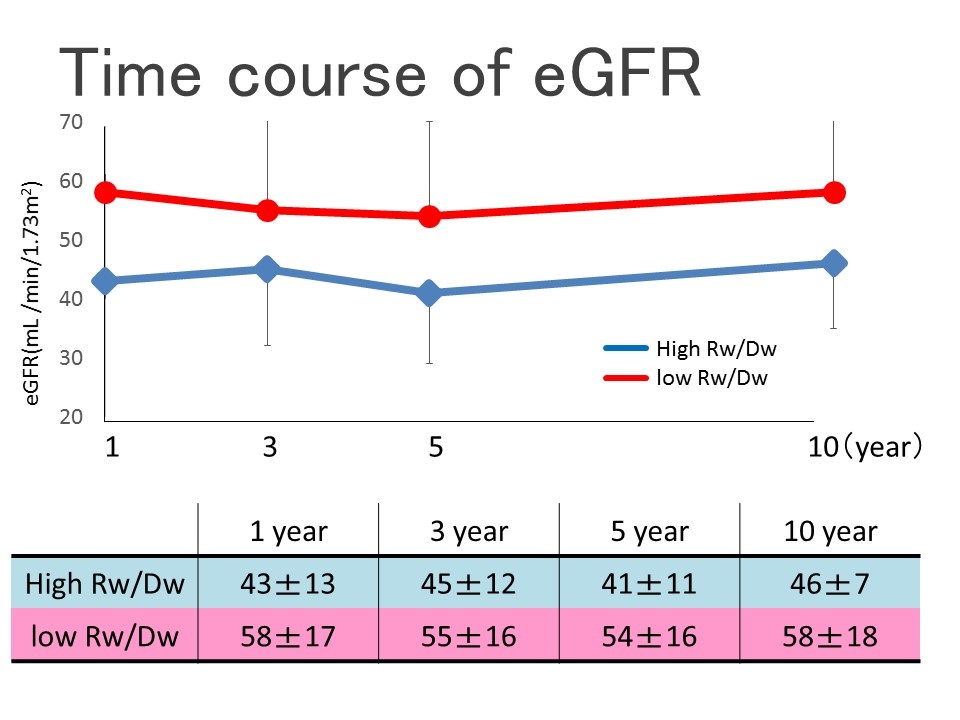Long-Term Clinical Outcomes of Kidney Transplant Recipients with Body-Size Mismatch Between Recipient and Donor.
1Urology, Hokkaido University Hospital, Sapporo, Hokkaido, Japan
2Urology, Asahikawa City Hospital, Asahikawa, Hokkaido, Japan
Meeting: 2017 American Transplant Congress
Abstract number: D231
Keywords: Glomerular filtration rate (GFR), Graft function, Graft survival, Kidney transplantation
Session Information
Session Name: Poster Session D: Living Donor Kidney Transplant II
Session Type: Poster Session
Date: Tuesday, May 2, 2017
Session Time: 6:00pm-7:00pm
 Presentation Time: 6:00pm-7:00pm
Presentation Time: 6:00pm-7:00pm
Location: Hall D1
[Purpose]
In living-donor kidney transplantation between large recipient and small donor, there are concerns of lower graft function and poor graft survival. Thus, we aimed to investigate long-term clinical outcomes of kidney transplant recipients with body-size mismatch between recipient and donor.
[Materials and Methods]
During the period from January 2000 to December 2015, 247 living-donor kidney transplants were performed at Hokkaido University Hospital and Asahikawa City Hospital. Among them, 178 kidney transplant recipients were selected after exclusion of pediatric and second transplant patients. Their mean recipient to donor body weight ratio (Rw/Dw) was 1.047. Then, we selected patients in 75 percentile of Rw/Dw higher than 1.201 (high Rw/Dw group, n=44), and in 25 percentile of Rw/Dw lower than 0.831 (low Rw/Dw group, n=44). The incidence of acute and chronic rejection, time course of eGFR, graft pathological changes, and graft survival were compared between the groups.
[Results]
Pathological changes based on Banff's classification during observational period had no significant difference between the groups. High Rw/Dw group had significantly lower eGFR (43±13mL /min/1.73m2) than low Rw/Dw group (58±17mL /min/1.73m2) at 1 year inversely correlated with difference in graft weight (160±38g and 200±49g, respectively). However, eGFR didn't change at 3, 5, and 10 years after transplant in each group (Figrure1). Incidence of acute and chronic rejection was not significantly different (treatment times/ follow period). Graft survival showed no significant difference (high and low Rw/Dw groups, 97% vs 100% at 5 year, 75% vs 100% at 10 year, respectively).
[Conclusions]
Body size mismatch between recipient and donor didn't cause poor pathological changes, progressively worsened graft function, or poor graft survival. 
CITATION INFORMATION: Takada Y, Iwami D, Hotta K, Kanagawa K, Higuchi H, Hirose T, Sasaki H, Shinohara N. Long-Term Clinical Outcomes of Kidney Transplant Recipients with Body-Size Mismatch Between Recipient and Donor. Am J Transplant. 2017;17 (suppl 3).
To cite this abstract in AMA style:
Takada Y, Iwami D, Hotta K, Kanagawa K, Higuchi H, Hirose T, Sasaki H, Shinohara N. Long-Term Clinical Outcomes of Kidney Transplant Recipients with Body-Size Mismatch Between Recipient and Donor. [abstract]. Am J Transplant. 2017; 17 (suppl 3). https://atcmeetingabstracts.com/abstract/long-term-clinical-outcomes-of-kidney-transplant-recipients-with-body-size-mismatch-between-recipient-and-donor/. Accessed December 21, 2025.« Back to 2017 American Transplant Congress
